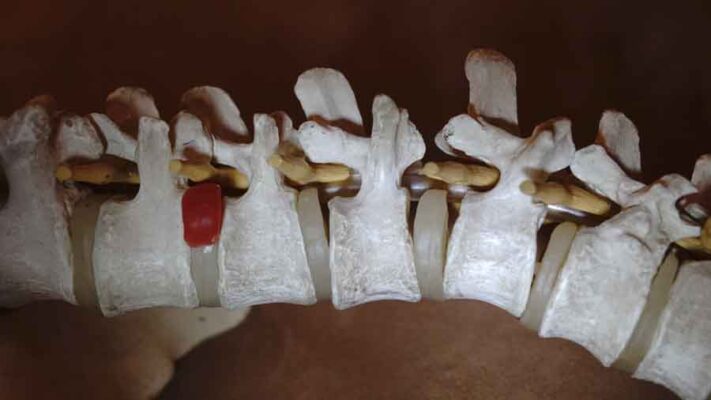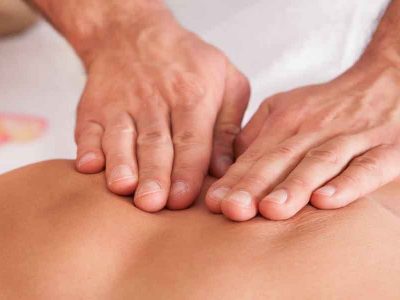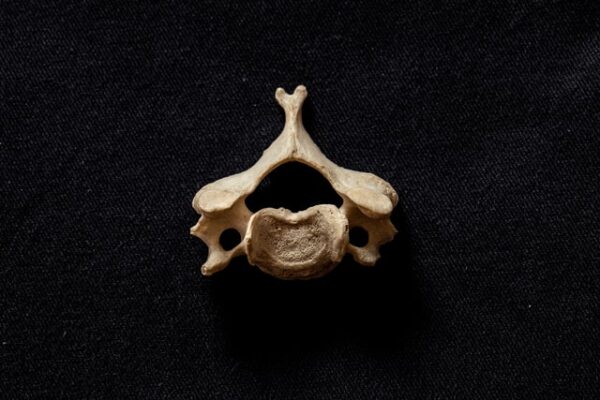As you age your spinal discs which are the shock absorbing pads between each vertebra start to wear out. This can lead to what is called degenerative disc disease or DDD for short.
The name is misleading as it is not actually a disease but a condition in which a damaged spinal disc causes pain. Everyone has some wear and tear of their spinal discs but not everyone will have pain. The process can start as early as your 20’s but you may not feel any pain or symptoms until decades later.
Degenerative disc disease is a common cause of back pain in older age.
What happens to the discs?
The discs which form a cushion between the vertebrae begin to dry out. This means that they are more prone to injury and are also smaller in height which in turn causes some disruption to the facet joints as well.
Both the extent of the breakdown and how it affects people varies massively and where one person may have severe disc breakdown and only mild pain, another may have minor disc damage and excruciating pain.


What are the discs?
In between each vertebra are shock-absorbing discs, known as spinal discs or intervertebral discs. They cushion your vertebrae and allow your back to bend, flex, and twist. The outer part of a disc is firm and contains nerves, so a bulge or tear can be very painful. Over one’s life, with repeated small injuries, you can develop microtears to this outer layer. Over time this makes you more susceptible to a full blown tear where the jellylike interior leaks out putting pressure on the adjacent nerve roots, causing severe pain.
Causes of DDD
Normal aging is not the only cause of disc degeneration. Other factors can cause or contribute to it.
- Your activity levels- activities of daily living such as a lot of lifting and twisting can cause wear and tear on your spinal discs.
- Injuries- any previous back injury can increase your risk of DDD.
- Genes- DDD tends to run in families, several genetic defects have been associated with changes inside the spinal disc that could make it weaker.
- Excess weight- Being overweight and obese increases the load your spine has to bear. That excess weight compresses the spinal discs. Compared with normal-weight people, those who are overweight and obese are more likely to have significant disc degeneration.
- Smoking. Some evidence suggests that smoking contributes to the degeneration of spinal discs.
What are the symptoms?
Although the spine is in a near-constant state of degeneration after our 20s, most people don’t start to experience symptoms of DDD until they reach their 60s or 70s.
70 to 80% of people have some sign of degeneration on an MRI, but not everyone has symptoms. Others have severe pain with pretty normal-appearing backs.
The degeneration of the spine is a very gradual progression, so you may not notice any symptoms at all in the early stages.
When you do start to have symptoms, the first one is probably going to be back pain. You may also notice it spreading, especially to your buttocks or upper thighs which is called sciatica which is common in DDD. Although the problem is disc damage, it usually affects other nearby structures – including the nerves.
Symptoms vary widely and may include:
- Feeling like your back has “seized” or “locked up”
- Neck pain
- Loss of motion in your spine
- Stiffness in your back
- Pain that radiates through your buttocks and legs or arms and hands
- Pain that worsens with extended periods of sitting
- Leg or foot weakness in severe cases


How Is Degenerative Disc Disease Diagnosed?
Back pain is so common that in the first instance you can treat it at home with painkillers, exercises and stretches, being careful with posture and other methods.
You should see a doctor if the pain is bothersome or recurring and normal painkillers are not touching the pain. Initially the doctor will take a history of the pain, what makes it worse, what time of day is worse, whether you have had any recent injury. You may be asked to assess your pain level on a scale of 0-10
See pain article- How to describe it
If the doctor wants to do further tests he may suggest the following-
- X-rays. These can show a decrease in the space between your discs, bone spurs (bony growths on your vertebrae), fractures, and other problems related to your bones. X-rays do not show the soft tissue very well.
- MRI (magnetic resonance imaging). This scan can reveal problems with your soft tissues. It can also show if your discs have shrunk, if your spinal canal has narrowed, or if your spinal discs are damaged.
Many symptoms of DDD can be relieved with simple methods of conservative treatment.
Non-drug treatments
In order to feel better does not always require medication. Your symptoms may improve with:
- Rest and ice for acute back pain episodes
- Stretching
- Physiotherapy
- Massage
- Heat therapy: heating pads, packs, or warm showers and baths
- Osteopathy
- Yoga
Medications
Depending on where you are on the pain scale, your doctor may recommend over-the-counter (OTC) or prescription drugs. This should be taken regularly to build up a level of pain relief so that you begin to move more normally. Muscle relaxants can also be prescribed if you are having acute muscle spasms.
Therapeutic injections
If the above does not work and you need more relief then injections are usually the next step. For DDD these include:
- Epidural corticosteroid shots, in which a powerful anti-inflammatory drug (the corticosteroid) goes into the fluid-filled space around your spinal cord
- Nerve blocks, in which pain-relieving medication goes directly into a nerve
- Trigger point injections, in which pain-relieving medication goes into the nearby muscle
Treatment is very individualized so what works for one person may not work for the other. It may take some trial and error before you land on a treatment regimen that helps relieve your specific symptoms.
What Are the Surgical Treatment Options for Degenerative Disc Disease?
Most of the time, DDD does not require surgical treatment. However, some cases of DDD don’t improve enough with conservative management. You may be considered a candidate for surgery if:
Your pain is increasing over time
Your pain has lasted without much relief for 12 weeks or more
Your pain is so severe it can only be relieved with opioids
Your pain is so severe that you are no longer able to do your normal activities
Your legs are getting weaker
These are three common surgical approaches for DDD.
- Discectomy: This procedure removes some or all of the damaged disc which can be helpful if it is pressing on a nerve.
- Spinal fusion: When a disc is severely damaged, it may be removed. To re-stabilize this part of the spine, the surrounding vertebrae are fused together.
- Artificial disc replacement: The damaged disc is removed and replaced with an artificial disc. In the neck especially, it can have fewer complications than spinal fusion.


What Are Some Tips for Living with Degenerative Disc Disease?
DDD cannot be completely prevented, but you may be able to slow down the progression of the condition and ease your painful symptoms. Some of the best ways to minimize the advancement of DDD are to:
- Achieve and maintain a healthy weight
- Live an active lifestyle that incorporates a mix of different exercises
- Build a strong core to support your back-See core exercises here
- Core strength exercises
- Do low-impact exercise, such as aquatics or Pilates
Being sedentary can make DDD worse, so be sure to incorporate a lot of standing and walking breaks into your day – especially if you have a job that requires you to sit a lot. In addition,
NB Urgently seek medical attention if you ever lose control of your bladder or bowel.
Severe complications from DDD are rare and most people with the condition can go onto to enjoy their normal activities of daily living. The important thing to remember with DDD is that if you are in pain, speak to your doctor about treatment options that can get you back on your feet.
FAQs
What causes degenerative disc disease?
In most cases, DDD does not have one specific cause, but is simply the result of normal aging in the spine.
How can I prevent degenerative disc disease?
The best way to keep your spine strong is to lead a healthy lifestyle, which includes getting regular exercise, eating a well-balanced diet, and avoiding harmful risk factors such as smoking and carrying excess weight.
How fast does degenerative disc disease progress?
Typically, the disease progression for DDD is very slow. Most people don’t even notice the effects of DDD until they are well into their 60s or 70s.
How is degenerative disc disease diagnosed?
DDD is diagnosed after an evaluation with your doctor, which will include a physical exam, assessment of your symptoms, and imaging studies such as X-ray and a MRI to get a closer look of what is happening with your spine.
What to do
See section on back exercises for all exercises to help keep your back mobile and strong.
Sources-Sports Injuries by Dr Lars Peterson
Spine universe

